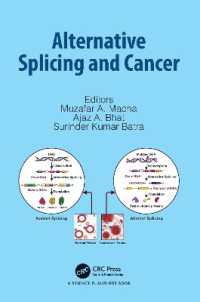- ホーム
- > 洋書
- > 英文書
- > Nature / Ecology
Full Description
Melatonin, once considered confined to animal systems, has now emerged as a vital bioactive molecule in plants—called phytomelatonin. Over the past two decades, it has gained recognition for its regulatory roles in plant growth, development, and defense. This book, Phytomelatonin: Regulating Development and Stress Protection in Plants, brings together the latest research on how phytomelatonin functions as a multitasking molecule, linking plant metabolism, hormonal signaling, and environmental response mechanisms.
The book offers a unique synthesis of molecular, physiological, and applied perspectives, making it the most comprehensive resource available on phytomelatonin's role in plant science. It highlights the molecule's potential in addressing pressing agricultural challenges such as climate-induced stress, reduced soil fertility, and the need for sustainable farming approaches.
Key Features:
Covers the biosynthesis, metabolism, and transport of phytomelatonin in various plant species
Details its regulatory role in seed germination, root architecture, flowering, fruiting, and senescence
Explains its interaction with key phytohormones under stress conditions including drought, salinity, and extreme temperatures
Presents recent advances in phytomelatonin-mediated gene expression and redox homeostasis
Discusses field applications including melatonin seed priming, foliar sprays, and soil drenching to improve stress resilience
Integrates insights from molecular biology, crop physiology, and natural farming practices
This book is an essential reference for researchers, graduate students, and professionals in plant biology, crop science, and environmental stress physiology. It serves as a foundational text and a forward-looking guide for those seeking to harness phytomelatonin in building climate-resilient and sustainable agriculture.
Contents
1. Phytomelatonin: Discovery, Metabolic Pathways, Occurrence and Distribution in Cellular Organelles, Site of Signal Perception, Transduction, and Mode of Action in Plants 2. Phytomelatonin: Isolation, Methods of Extraction, Detection, and Quantification Through High-Throughput Technological Interventions 3. Methodological Aspects to Exogenously Source the Phytomelatonin Supplementation in Plants Exposed to Environmental Stressors 4. Root Morphogenesis: The Role of Phytomelatonin Under Plant Stress 5. Phytomelatonin Regulates Uptake, Transport, and Assimilation of Mineral Nutrients and Aquaporins to Attenuate Ionic and Osmotic Stability with Redox Modifications Under Environmental Stressors 6. Exploring Phytomelatonin-Induced Physiological and Biochemical Responses to Heavy Metal Stress in Plants 7. Role of Phytomelatonin in Uptake, Transport, and Assimilation of Mineral Nutrients in Plants 8. Phytomelatonin Biology Serving as a Driving Force in Regulating Plant Growth and Development Under Optimal/Environmental Stressors/Biotic Interferences 9.Interplay between Phytomelatonin and Gasotransmitters under Environmental Extremes 10. Omic(s), Transgenic, and Bioinformatics Approaches/Tools to Up-regulate Phytomelatonin-Mediated Environmental Stress-Tolerance in Crop Lines







